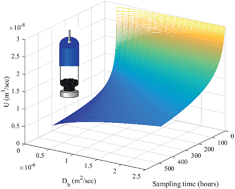Modelling permeation passive sampling: intra-particle resistance to mass transfer and comprehensive sensitivity analysis†
Abstract
A mathematical model developed previously to describe the sampling process in permeation passive samplers with non-porous adsorbents and evaluated using the Waterloo Membrane Sampler (WMS) is here extended to include adsorbents with porous particles. This work was motivated by the need to expand the model applicability to include the various types of adsorbents used in the WMS, and to develop a deep understanding of the model sensitivity towards required parameters. The effects of intraparticle porosity on the effective diffusivity of the analyte in a bed of porous particles and on the mass transfer coefficient for analyte transport from the interparticle void phase to the porous solid phase are both evaluated. Experimental validation of the applicability of the model on adsorbents with microporous particles was carried out using the WMS containing Anasorb 747, a carbon-based adsorbent with highly porous particles. Good agreement between the experimental and model results was found. A comprehensive sensitivity analysis was also conducted to identify the parameters with the greatest influence on the results of the calculated uptake rate. This analysis included two types of adsorbents with different sorption strengths. The results showed that the uptake rate sensitivity is limited to parameters related to mass transfer in the membrane for strong adsorbents. On the other hand, sensitivity to parameters related to mass transfer in the sorbent bed becomes more significant as the strength of the adsorbent decreases; however, this effect can be reduced by increasing the membrane thickness. Influential parameters in the sorbent bed are also affected by the temperature. Nevertheless, the contribution of this change to the total effect of temperature change on the uptake rate is expected to be negligible within the small range of temperature variations usually encountered during a single environmental sampling event, especially in soil-gas sampling which is the most widely used application of the WMS.



 Please wait while we load your content...
Please wait while we load your content...